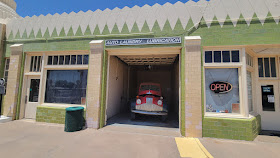It rises like a mirage, only sharper. A beacon of green and cream-colored tile shimmering under the West Texas sun, sharp as a matchstick, silent as a church. You don’t stumble upon the Conoco Tower—you see it coming. On this stretch of Route 66, where the landscape seems to stretch itself thin across the horizon, it stands like a promise. Not of salvation, perhaps, but of service. Gasoline, oil, tires. Cold soda in the cooler. A reason to stop.
Built in 1936, the Tower Station and U-Drop Inn Café were born of ambition and the architectural optimism of the day. They called the style "zigzag moderne," but there's nothing especially modest about it. This was commercial architecture with its chin up. Designed by Joseph Berry and constructed by local entrepreneurs, it was said to be one of the first businesses in Shamrock built explicitly to attract highway traffic. The idea was simple: make it beautiful enough, and people will pull over. It worked.
What amazes me is not that it survived the collapse of Route 66—most things didn’t—but that it survived the decades of indifference afterward. When the interstates came and the cars stopped pulling in, when the pumps stopped running and the café shut its doors, the tower stood. Empty, perhaps, but unbowed. It became something else—an icon not of convenience, but of memory.
And now it’s immortal in two ways: on the National Register of Historic Places, and in animated form. In Cars (2006), it became the model for Ramone’s House of Body Art—bright, stylized, instantly familiar. I wonder how many kids first came to know Route 66 not through a map or a road trip, but through a talking car and a forgotten town brought to life in pixels. If so, they still got something right—this tower belongs to dreams.
We stopped to stretch our legs. The building is now a visitor center, tastefully preserved, glowing even in the midday light. I stepped inside, but the real magic was outside. I walked slowly past where the pumps once stood, stood under the shade of the tower, and looked down the empty road. For a second, it felt like I could hear the old sounds: a bell ringing as a car pulls in, the rattle of a mechanic’s tools, a mother telling her kids to hush and eat their sandwiches.
They don’t build them like this anymore. Maybe they never really did. Maybe this one was always meant to be the last.



